| Queensland Railways 1270 class | |||||||||||||||||||||||||||
|---|---|---|---|---|---|---|---|---|---|---|---|---|---|---|---|---|---|---|---|---|---|---|---|---|---|---|---|
 1270 and 1281 in Auchenflower in November 1985 | |||||||||||||||||||||||||||
| |||||||||||||||||||||||||||
| |||||||||||||||||||||||||||
| |||||||||||||||||||||||||||
| |||||||||||||||||||||||||||
The 1270 class were a class of diesel locomotive built by English Electric, Rocklea for Queensland Railways between 1964 and 1966.
| Queensland Railways 1270 class | |||||||||||||||||||||||||||
|---|---|---|---|---|---|---|---|---|---|---|---|---|---|---|---|---|---|---|---|---|---|---|---|---|---|---|---|
 1270 and 1281 in Auchenflower in November 1985 | |||||||||||||||||||||||||||
| |||||||||||||||||||||||||||
| |||||||||||||||||||||||||||
| |||||||||||||||||||||||||||
| |||||||||||||||||||||||||||
The 1270 class were a class of diesel locomotive built by English Electric, Rocklea for Queensland Railways between 1964 and 1966.

The 1270 class was devised by English Electric engineer Stan Lyons, based on the body design of North American road switcher but using the same engine and generator as the 1250 class. The first 12 units had the same English Electric 525 traction motors as the 1250 class. The remaining units had improved English Electric 548 traction motors with a slightly higher tractive effort. The final six units had dynamic brakes. [1]
In 1965, 1281 was named Century and painted in a commemorative gold and white livery to mark the centenary of the first railway in Queensland. [2]
They were used on grain trains between the Darling Downs and Brisbane, ore trains on the Mount Isa line and coal trains on the Moura line. [3] With higher power diesel locomotives becoming available in the 1970s, the 1270s were moved to general freight. [2]
The 1270 class were displaced from coal traffic with the electrification of coalfields lines from 1986. [1] All were withdrawn between 1987 and 1989. Two units were retained by the Queensland Rail Heritage Division [2] [4] and the remainder were scrapped.
| Number | Serial number | In service | Withdrawn | Scrapped | Notes |
|---|---|---|---|---|---|
| 1270 | A.092 | 26 October 1964 | 24 November 1988 | Queensland Rail Heritage Division, stored | |
| 1271 | A.090 | 9 November 1964 | 19 January 1989 | October 1991 | |
| 1272 | A.091 | 23 November 1964 | 18 November 1989 | January 1992 | |
| 1273 | A.093 | 7 December 1964 | 8 November 1988 | October 1991 | |
| 1274 | A.094 | 21 December 1964 | 18 January 1989 | October 1991 | |
| 1275 | A.095 | 7 January 1965 | 30 December 1988 | September 1991 | |
| 1276 | A.098 | 23 April 1965 | 17 January 1989 | November 1991 | |
| 1277 | A.099 | 30 April 1965 | 23 January 1989 | November 1991 | |
| 1278 | A.100 | 13 May 1965 | 17 November 1988 | September 1991 | |
| 1279 | A.101 | 21 May 1965 | 19 November 1988 | November 1991 | |
| 1280 | A.102 | 22 June 1965 | 18 November 1988 | November 1991 | |
| 1281 | A.103 | 30 July 1965 | 4 January 1989 | Named Century. Queensland Rail Heritage Division, Workshops Rail Museum | |
| 1282 | A.108 | 6 November 1964 | 17 November 1987 | October 1991 | |
| 1283 | A.113 | 21 February 1966 | 29 October 1988 | November 1991 | |
| 1284 | A.107 | 7 December 1965 | 21 November 1988 | October 1991 | |
| 1285 | A.106 | 26 November 1965 | 31 October 1988 | January 1992 | |
| 1286 | A.112 | 4 February 1966 | 16 January 1989 | October 1991 | |
| 1287 | A.115 | 18 March 1966 | 30 December 1988 | November 1991 | |
| 1288 | A.114 | 7 April 1966 | 21 November 1988 | October 1991 | |
| 1289 | A.117 | 22 April 1966 | 22 December 1988 | October 1991 | |
| 1290 | A.119 | 29 April 1966 | 14 November 1988 | November 1991 | |
| 1291 | A.120 | 13 May 1966 | 25 September 1989 | November 1991 | |
| 1292 | A.122 | 3 June 1966 | 17 November 1988 | November 1991 | |
| 1293 | A.123 | 10 June 1966 | 16 November 1988 | January 1992 | |
| 1294 | A.126 | 17 June 1966 | 22 December 1988 | October 1991 | |
| 1295 | A.127 | 1 July 1966 | 4 January 1989 | September 1991 | |
| 1296 | A.128 | 15 July 1966 | 5 April 1988 | October 1991 | |
| 1297 | A.129 | 28 July 1966 | 10 August 1987 | December 1989 | |
| 1298 | A.130 | 12 August 1966 | 16 January 1989 | November 1991 | |
| 1299 | A.131 | 12 August 1966 | 21 January 1988 | October 1991 |

A locomotive is a rail transport vehicle that provides the motive power for a train. If a locomotive is capable of carrying a payload, it is usually rather referred to as a multiple unit, motor coach, railcar or power car; the use of these self-propelled vehicles is increasingly common for passenger trains, but rare for freight trains.
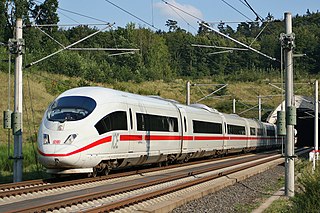
A multiple-unit train or simply multiple unit (MU) is a self-propelled train composed of one or more carriages joined, which when coupled to another multiple unit can be controlled by a single driver, with multiple-unit train control.

A diesel locomotive is a type of railway locomotive in which the power source is a diesel engine. Several types of diesel locomotives have been developed, differing mainly in the means by which mechanical power is conveyed to the driving wheels. The most common are diesel-electric locomotives and diesel-hydraulic.

An electric locomotive is a locomotive powered by electricity from overhead lines, a third rail or on-board energy storage such as a battery or a supercapacitor. Locomotives with on-board fuelled prime movers, such as diesel engines or gas turbines, are classed as diesel–electric or gas turbine–electric and not as electric locomotives, because the electric generator/motor combination serves only as a power transmission system.
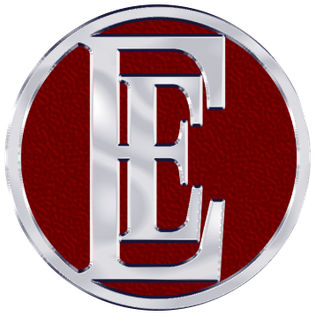
The English Electric Company Limited (EE) was a British industrial manufacturer formed after the armistice ending the fighting of World War I by amalgamating five businesses which, during the war, made munitions, armaments and aeroplanes.

Railway electrification is the use of electric power for the propulsion of rail transport. Electric railways use either electric locomotives, electric multiple units or both. Electricity is typically generated in large and relatively efficient generating stations, transmitted to the railway network and distributed to the trains. Some electric railways have their own dedicated generating stations and transmission lines, but most purchase power from an electric utility. The railway usually provides its own distribution lines, switches, and transformers.

The British Rail Class 08 is a class of diesel-electric shunting locomotives built by British Railways (BR). As the standard BR general-purpose diesel shunter, the class became a familiar sight at major stations and freight yards. Since their introduction in 1952, however, the nature of rail traffic in Britain has changed considerably. Freight trains are now mostly fixed rakes of wagons, and passenger trains are mostly multiple units or have Driving Van Trailers, neither requiring the attention of a shunting locomotive. Consequently, a large proportion of the class has been withdrawn from mainline use and stored, scrapped, exported or sold to industrial or heritage railways.

The British Rail Class 25, also known as the Sulzer Type 2, is a class of 327 diesel locomotives built between 1961 and 1967 for British Rail. They were numbered in two series, D5151–D5299 and D7500–D7677.

LMS No. 10000 and 10001 were some of the first mainline diesel locomotives built in Great Britain. They were built in association with English Electric by the London, Midland and Scottish Railway at its Derby Works, using an English Electric 1,600 hp diesel engine, generator and electrics.
A hybrid train is a locomotive, railcar or train that uses an onboard rechargeable energy storage system (RESS), placed between the power source and the traction transmission system connected to the wheels. Since most diesel locomotives are diesel-electric, they have all the components of a series hybrid transmission except the storage battery, making this a relatively simple prospect.

The GT46C-ACe is a model of Australian diesel-electric locomotive designed and built between 2007–present by Downer Rail at its Cardiff Locomotive Workshops using Electro-Motive Diesel components until 2014, with later units built in Muncie, Indiana.
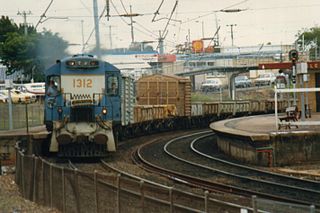
The 1300 class were a class of diesel locomotive built by English Electric, Rocklea for Queensland Rail between 1967 and 1972. They were later sold to AN Tasrail.
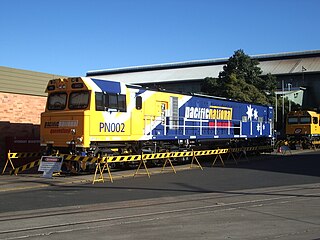
The GT42CU AC is a model of diesel electric locomotives manufactured by EDi Rail, Maryborough between 1999 and 2005 under licence from Electro-Motive Diesel, for use on narrow gauge railways in Queensland.
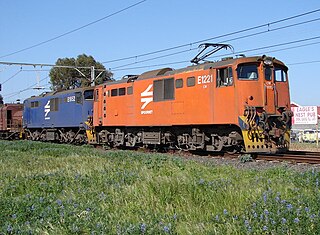
The South African Railways Class 6E of 1970 was an electric locomotive.
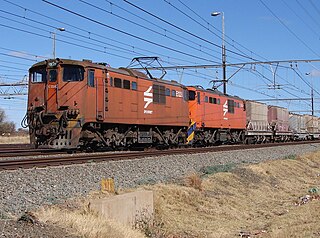
The South African Railways Class 6E1, Series 1 of 1969 was an electric locomotive.

The South African Railways Class 11E of 1985 is an electric locomotive.
Aurizon electric locomotives are used by Australian rail operator Aurizon in Queensland.
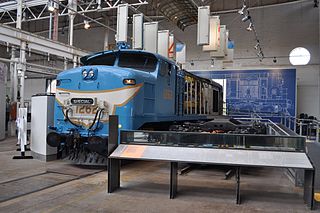
The 1250 class were a class of diesel locomotive built by English Electric, Rocklea for Queensland Railways between 1959 and 1963.
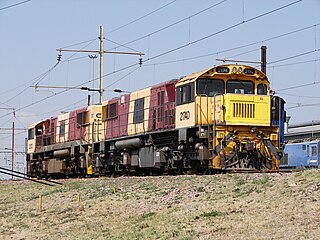
The Queensland Railways 2170 class is an Australian diesel-electric locomotive.

The Indian locomotive class WAG-4 is a class of 25 kV AC electric locomotives that was manufactured by CLW in the late 1960s for Indian Railways. The model name stands for broad gauge (W), AC Current (A), Goods traffic (G) engine, 1st (1). A total of 186 WAG-4 locomotives were built by The European Group 50 Hz Group/European Group/50 Cycles Group (consortium) between 1967 and 1969. They entered service in 1967.